Sigma 18-200 mm f/3.5-6.3 II DC OS HSM
3. Build quality and image stabilization
In the photo below the tested Sigma 18-200 mm OS II is positioned between the Sigma 1.4/30 and the Canon EF-S 18-55 mm kit lens.
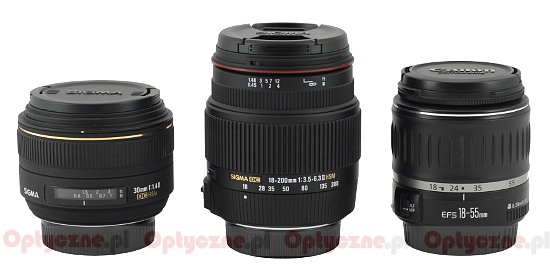 |
Please Support UsIf you enjoy our reviews and articles, and you want us to continue our work please, support our website by donating through PayPal. The funds are going to be used for paying our editorial team, renting servers, and equipping our testing studio; only that way we will be able to continue providing you interesting content for free. |
- - - - - - - - - - - - - - - - - - - - - - - - - - - - - - - - - - - - - - - - - - - - - - - -
The aperture is not strong suit of the tested lens. The aperture value of f/4.0 can be seen already near 26 mm focal length, the f/4.5 aperture – near 36 mm, f/5.0 – at 60 mm, f/5.6 – near 100 mm, the value of f/6.0 – at 135 mm and f/6.3 at less than 180 mm. These results are still better than those of the 18-55 mm kit instrument which, at the maximum focal length, has the aperture of f/5.6 after all. Every amateur photographer who swaps a standard kit for the Sigma will gain a bit when it comes to fastness.
The lens starts with a metal bayonet mount with contacts. The diameter of a hole in the mount is 33 mm, containing a ‘double trombone’ mechanism with a rear element (to move it on zooming). For a change the rear element is only 19 mm in diameter. At the shortest focal length it is situated on the same level as the mount and at 200 mm it hides almost 5 cm inside the barrel. The tube is darkened and well-matted inside – you can’t see any shiny elements or electronics parts.
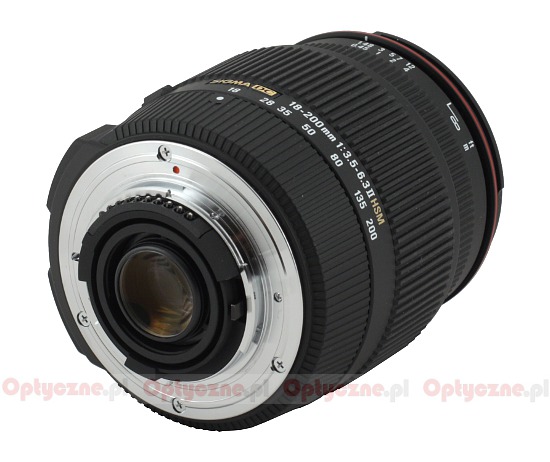 |
When you move to the proper casing of the lens, padded with black plastics, on the left you can find a focusing mechanism mode switch (AF/MF) and a stabilization switch (OS ON/OFF).
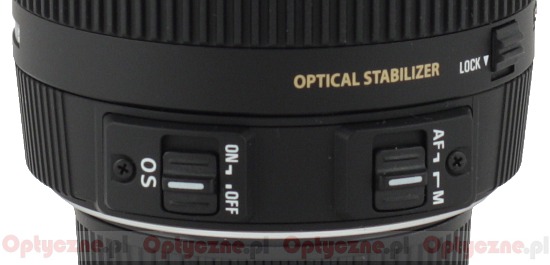 |
The next element of the lens is a zoom ring, almost 4 cm wide. The majority of it consists of rubber ribs. Apart from the ribs you can also find the name and parameters of the lens, focal lengths markings and a zoom LOCK switch, used to block the lens at 18 mm. It usefulness is limited, though, because the lens specimen, used in our test, didn’t extend even when pointed downwards and given a vigorous shake. The work of the ring itself is not very even, with much more resistance in the middle of the focal range than on both ends. The usage, mainly because of its dimensions and the ribbing, remains still quite comfortable.
A manual focus ring is the next part of the casing. The ring is 18 mm wide, half of it ribbed, the second half occupied by a distance scale, expressed in meters and feet. The ring is active only in the MF mode and it is quite loose then, not helping when it comes to precise settings. Its working range, which is very narrow, doesn’t help either. Running through the whole scale needs a turn through only about 40 degrees – this value is really insufficient.
The lens ends with a hood thread which surrounds a non-rotating filter thread, 62 mm in diameter, which is situated round a front element, almost 49 mm in diameter.
The front element system extends with the increase of the focal length on a telescopic tube, made of plastics. The tube doesn’t have any lateral play and doesn’t bend under pressure. When we move the lens, however, you can hear a slight clatter, most likely coming from the stabilization system. When you set the lens at 200 mm its total length reaches almost 16 cm - its dimension, compared to the folded position, increases almost two times.
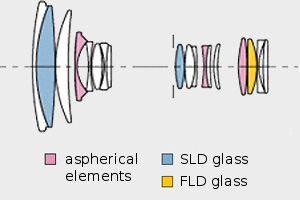
The new Sigma 18-200 mm is optically the most complicated 18-200 mm lens, currently available on the market. It features overall 18 elements positioned in 14 groups. Its predecessor had the same number of elements but less groups. The equivalents from Canon and Nikon have “only” 16 elements. The number of special elements in the new Sigma is also impressing. Its predecessor had one low-dispersion SLD glass and three aspherical elements. The new model boasts one element made of fluoride FLD glass, two SLD glass elements, two aspherical elements made of lathe glass and one hybrid aspherical element as well. Inside you can also find an aperture with seven diaphragm blades which can be closed down to f/22-40, depending on the focal length.
You also get both caps and a petal-type hood in the accessory kit.
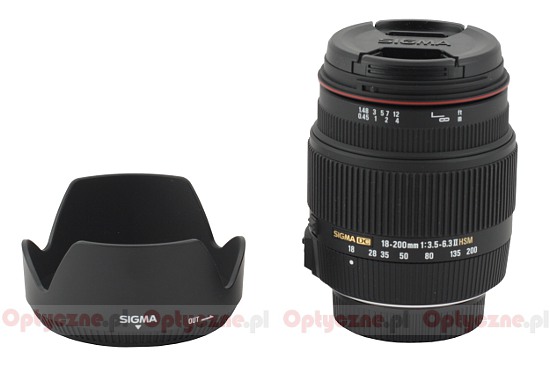 |
Image stabilization
Already in the case of the Sigma 18-200 mm f/3.5-6.3 DC OS the producer boasted about using the stabilization with efficiency level of 4 EV. Our test showed that value in reality was much closer to 2 EV than those declared 4 EV. How does the new lens fare here? Let’s glance at a graph below, showing its stabilization efficiency at 200 mm focal length.
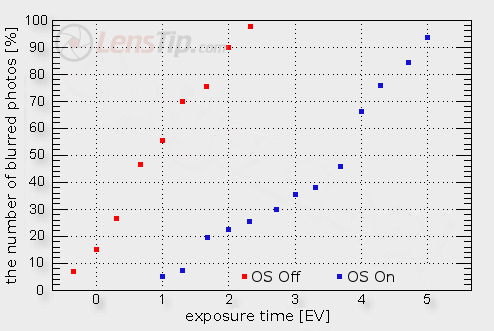
Here we present the percentage of fuzzy photos depending on the exposure time, expressed in EV (and 0 EV is the equivalent of 1/160 of a second). As you see the maximum distance between two curves reaches almost 3 EV and so we determine the value of the stabilization efficiency. This result is good, better than in the case of the tested lens’s predecessor, but, at the same time, a bit worse than that of the best (and the most expensive) lenses produced by other competitors which can have stabilization systems with efficiency even slightly exceeding the level of 4 EV.






